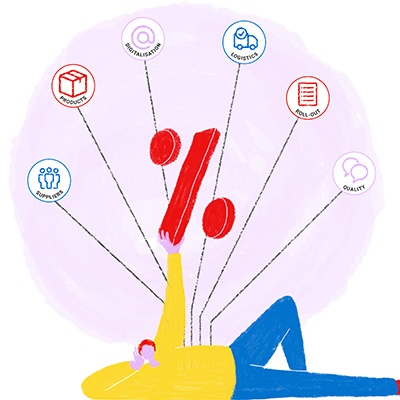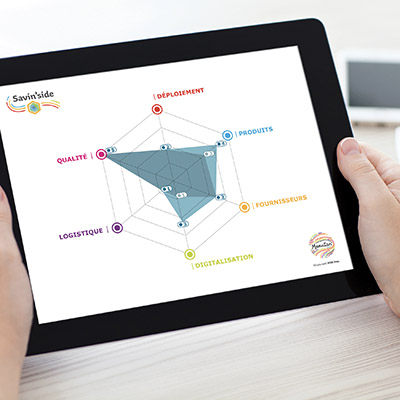Nowadays, any effective B2B e-commerce website needs to integrate all the features of a B2B (Business to Business) procurement tool within an environment very close to that of B2C (Business to Customer) solutions. For internal customers, being able to use a website close to what they use every day in their personal life is a real deciding factor. A few website features now seem essential: Customisation, tracking, flexibility, etc. Such a platform focused on user experience guarantees effective deployment of supplier contracts while meeting current digitalisation challenges.
A personalised account for customers
First, a B2B e-commerce website should offer a personalised account to all of its users. This concerns all data (websites, delivery and billing addresses, contact details and statuses, etc.).
This allows customers to:
- Log in safely or to use access codes for automatic recognition. They can then choose their delivery site from the list of pre-registered sites, for example.
- Apply the negotiated contract terms, both in terms of prices (discounts and fixed rates) and product catalogue (exclusive products or, on the contrary, products that have been removed upon request).
- Comply with negotiated delivery or billing terms in the same way as if the order came through another channel (fax, email, telephone, etc.).
- Make sure procurement requests comply with validation rules based on users, order amounts or budgets. It is also possible to define roles for each user (buyer/validator).
- Optimise their browsing experience by tailoring product recommendations based on user preferences in order to suggest the best product at the right time during the buying journey.
Transaction monitoring tools
Any B2B website must also provide tools to manage, monitor, and track the purchases made by customers, with a functional coverage similar to that of P2P (Procure-to-Pay) software. This is essential for users, but also for buyers who are responsible for structuring the procurement strategy.
This includes:
- Fast quote handling (48 hours) and the ability to convert quotes into orders in one click.
- Order tracking, as well as delivery tracking via a track & trace system.
- Full or partial handling of product returns, as well as their monitoring, regardless of the reasons, with replacement or refund.
- Reporting of what customers have purchased over given periods.
Real-time information
In the B2C world, updating information in real time is already a must. This firstly concerns the offer itself so that customers can access new arrivals and avoid ordering obsolete products.
However, it can also be extended to stock management and delivery times to give users even more visibility.
Comprehensive product content
For B2B procurement, product content is even more important. Indeed, it meets specific requirements, as with personal protective equipment (PPE), for example.
For each product, a B2B website should therefore offer key information (pictures and text description), but also more detailed elements, such as:
- Technical attributes (brand, dimensions, colours, materials, maximum load, etc.);
- Accompanying documents (assembly instructions, user guide, certificate, etc.);
- Environmental and social benefits (product made from recycled materials, reduced energy consumption, etc.);
- Labels (EU Ecolabel, Ecocert, PEFC, etc.);
- Associated services (installation/assembly, financial leasing, etc.).
Advanced search features
For an optimal buying journey, customers must be able to find the products they need right away. Nowadays this approach goes far beyond a search engine with autocomplete functionality, however high-performing it may be.
Advanced search filters
This allows users to refine results by selecting specific attributes: Price, brands, etc. Given the increasing importance of environmental criteria, it can also be a good idea to enable customers to choose a product based on its origin or eco-responsible nature.
Automatic suggestions
This feature is used to automatically recommend relevant alternatives to site visitors based on a given reference. Thanks to an algorithm, customers can be suggested products based on their browsing history as well as similar, complementary or lower-priced alternatives (downselling), etc.
Implementation of online shops
To make browsing easier, e-commerce websites can also offer themed categories. These online shops will focus on a product range, based on a concept or characteristic (warehouse equipment, eco-responsible products, etc.).
Optimised mobile experience
In the world of online sales, mobile browsing is becoming more widespread, especially in the product and service search phase. This reality applies as much to B2C as to B2B.
According to a study conducted by the Boston Consulting Group, 80% of buyers use their mobile at work and over 60% of them say this channel played an important role in a recent purchase[1]. It now appears fundamental for websites to be “responsive”, meaning their design adapts to all screen resolutions.
Customer service
As part of their online buying journey, users may need additional information. Sometimes, having a well laid-out B2B website and quality product content isn’t enough. In this case, it is necessary to offer an efficient customer support that will help internal customers solve their problems.
To achieve this, B2B websites need to display clear contact information, provide additional reference material (FAQ, tutorials, etc.), and offer phone support and/or instant messaging, for example. Note that a supplier (or distributor) has structured customer support and the required product expertise to provide these types of services, unlike an online marketplace.
Flexible payment options
When it comes to payment, companies have their own specificities. This is why it is essential to adapt to all scenarios by offering a wide range of possibilities. This makes payment easier and reduces cart abandonment.
For a B2B website, this means having users set up their payment methods (purchasing card, bank transfer, credit card, administrative order, cheque, etc.) as they create their company account. Then they can pick the option that suits them best.
B2B e-commerce websites are now at the crossroads between an e-tailer website and a P2P platform that is fully integrated within the procurement system of customers. In the digital procurement era, businesses thus benefit from an optimal level of convenience, efficiency and performance thanks to this hybrid platform.
[1] BCG, Mobile Marketing and the New B2B Buyer, 2017









